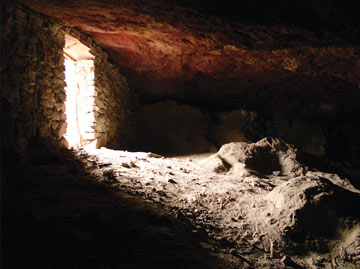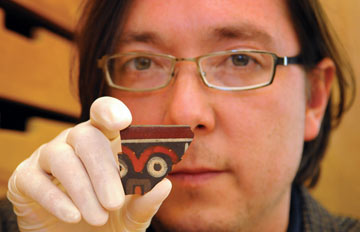|
NEWS NOTES
Pumping iron in Peru
 Matthew Edwards |
| Light shines through the entrance to an ancient hematite mine in Peru. |
Ancient civilizations in Peru mined silver, gold and copper long before the Spanish arrived, smelting the metals to create ceremonial knives and breathtaking adornments. They also gathered iron ore, but for a different purpose: to color their clay pottery. Now archaeologists have uncovered the source of some of that pigment — a 2,000-year-old hematite mine in the foothills of the Peruvian Andes.
“A lot of the pre-Columbian ceramics that you see are going to have sort of a rusty brown color,” says William E. Brooks, a mineral commodity specialist at the U.S. Geological Survey in Reston, Va., who was not involved in the study. “That’s exciting because it’s probably from a mine like this.” Previous research showed that the red paints used on many of these pots are rich in iron, but until now archaeologists could only speculate about the source of the mineral.
The hematite mine, called Mina Primavera, first came to the attention of Kevin Vaughn, an archaeologist at Purdue University in West Lafayette, Ind., a few years ago. With the help of Peruvian miners, he and his colleagues located the entrance to the mine and began excavating the floor, unearthing pottery shards, corn cobs, bits of shell, beads and textiles. They also found several stained depressions on the mine floor that appear to be the mortars where the ore had been ground into pigment. Vaughn estimated the age of the mine by closely examining the pottery, and radiocarbon dating of the corn cobs confirmed that the mine had been used during the first few centuries A.D. by the Nasca people (also spelled Nazca) and later, until A.D. 1500, by other cultures.
 Purdue News Service photo/David Umberger |
| Kevin Vaughn holds a pottery fragment he discovered at Mina Primavera. |
For the past six years, Vaughn has been trying to better understand how the Nasca — famous for their colossal drawings of animals and geometric shapes that are only visible from the sky — manufactured clay pottery and what role it played in their daily lives. “For this particular culture, multi-color pottery was very important,” he says. So he and his colleagues are working to identify sites where the Nasca acquired the necessary raw materials, including the colorful paints.
“About 2,000 years ago, people [in South America] stopped using organic dyes on pottery and they started to use mineral based pigments,” Vaughn says. Colored minerals can be painted on pottery before it’s fired in a kiln, so they last much longer than organic paints, he says. But until now, no ancient iron pigment mines had ever been found. “It’s the only iron ore mine with clear evidence for pre-Hispanic activity,” Vaughn says.
Vaughn and his colleagues, who published their discovery in December’s Journal of the Minerals, Metals & Materials Society, estimate that, over the course of 1,400 years, 3,710 metric tons of hematite were removed using rough stone axes and hammerstones.
“They needed mineral pigments to decorate the various parts of their lives,” Brooks says. “An incredible economy was going on.”

 Subscribe
Subscribe


